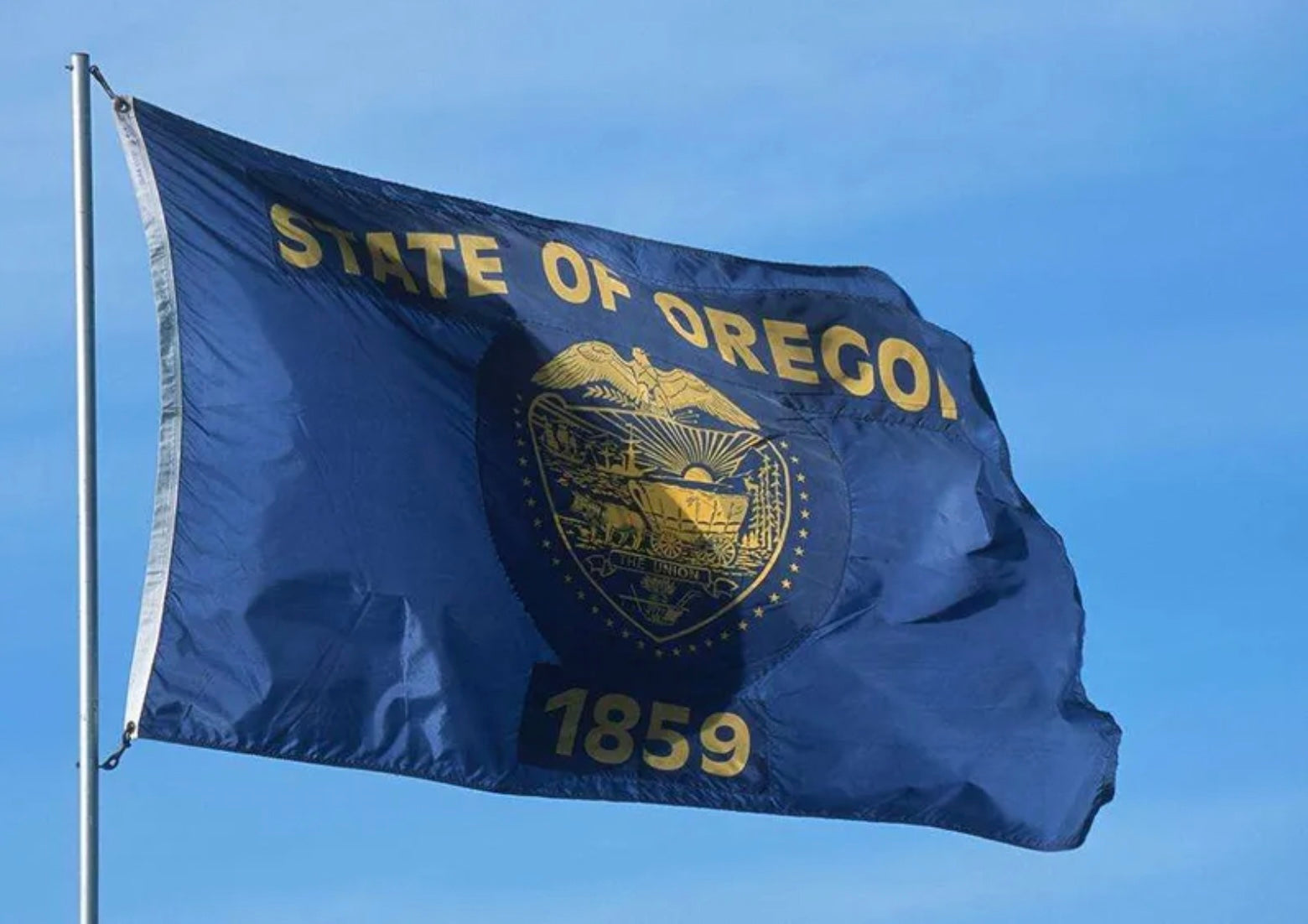Out of the 50 United States flags, only one of the states has a flag that appears differently on either side. Although this was more of a common occurrence of the past, read more below to understand why Oregon is the sole remaining state who chooses to weave their state flags in this particular measure.
Background and Design
Created in the year 1925, this navy blue background riddled with golden text and imagery represents the Oregon state colors on full display. Similar to the way nations such as the United States created their flag based upon their individual history and morals, the Oregon flag contains a similar story.
One side of this flag features a portion of the state seal, along with the year it joined the Union: 1859. At the very top, “THE STATE OF OREGON” in all caps catches the eye. The shield imagery is surrounded by 33 stars in a symmetrical fashion.
The specific star count is inspired by Oregon becoming the 33rd state to join America. The dress flag version also has a gold border, but the standard edition contains a navy color throughout.
The shield symbol in the center illustrates an elk, a covered wagon, and an ox team with the Pacific Ocean in the background in front of a descending sun. On the open water, there is a British man-o-war ship departing and an American merchant ship arriving on the Oregon shores.
This bit of imagery is there to symbolize breaking away from British rule. On the opposite side of the flag is pictured the state animal, a beaver, also in the same gold font.
History
The first flag design was created by Blanche Cox and Majorie Kennedy, who received sponsorship from Meier & Frank, the store that they both worked for. The original piece that they created is still intact today, almost a century later. The flag was donated to the University of Eastern Oregon in 1954 by the grandson of governor Pierce Walter, some 30 years after it was created.
Although the Oregon flag has never been officially altered, there was a move made to change it in 2009. A major state newspaper, The Oregonian, sponsored a contest for redesigning it where readers would have the chance to vote on which illustration they liked the most.
A man named Randall Gray was victorious in this competition, creating a flag image that resembled a few similarities to the one being used already by the 33rd state but very much different. His design featured the same navy blue background in the center of the flag, but he added a pair of white and green stripes to the North and South of this piece in the middle.
On top of the navy blue, he included the state animal next to a singular star, representing Oregon’s statehood in America. The state legislature of Oregon actually constructed a bill to permanently change the flag to Gray’s design. However, it never ended up coming to a vote.
Senator Anderson Laurie proposed a separate bill in 2013 to change a few things about the flag as well. Laurie wanted to see a navy field on the hoist of the flag and a golden field on the fly of the design. On top of these, she also wanted there to be a navy blue stripe vertically installed on the fly with a white star visible in the center.
The canton of her flag design was to feature the state animal in gold font color. For those who aren’t sure of what a canton is, this refers to the upper left portion of a rectangle flag design (e.g., the stars in the United States flag). Senator Laurie also proposed to have the same design on either side of the flag, obviously much different than what the state currently uses. Oregon, to this day, remains the only unique state flag that has kept this design over the years.
Other United States Who Used Two-Sided Flags in the Past
Although Oregon is the only state that still currently has a different design on the obverse and reverse sides. There were others who used to do the same before altering theirs over time. Prior to the state reaching its end goal of what we have today, it first proposed their two-sided piece to Congress in 1905
West Virginia
Yes, that’s correct—West Virginia used to also have a two-sided flag as well, up until 1929. They actually had two separate versions of their state flag possessing this feature before they reached the design that they have today. In 1905, their first version displayed a mountain laurel meant to represent the Louisiana Purchase Exposition and the state itself.
This array of flowers was cast on top of a white background bordered by a blue one on the edges of the flag. This illustration on the reverse was centered inside of a “coat of arms” on top of a plain white background, bordered with blue. Inside, the coat read “Montani Semper liberi,” which translates to “Mountaineers are always free.”
For two years, the state kept this version and then almost flip-flopped the entire design from the obverse to reverse sides. From 1907 to 1929, the laurel was moved to the backside of the flag. The former obverse side was now in the front: it remained intact with the addition of a red banner that read “STATE of WEST VIRGINIA” in yellow font.
Despite this unique design like Oregon’s flag, the Mountaineers altered their flag design again in 1929 to what it is today. The reasoning behind this permanent switch came on behalf of financial reasons. The design was deemed impractical to manufacture during a Senate Joint Resolution.
The cost at the time made it very difficult for schools of the state and others to afford to be able to buy the flag for use. As a result, it was deemed desirable for the state to adopt a new state flag with unilateral sides going forward.
Massachusetts
The second to last remaining state that kept a separate design on their state flag most recently was none other than Massachusetts. This state actually adopted their current version and ended the two-sided design only in 1971. However, like many other flag creations, there was a lot of effort and time that went into finishing the product.
The seal of the Massachusetts colony was constructed in 1629 using native trees and Indigienous people. The colony used a pine tree over the English flag in 1686 to resemble the region of New England, but this was eventually shot down by the monarchy across the ocean. As a result, in April of 1776, the Massachusetts Navy began using the Pine Tree Flag—a design with a white field (background) with a green pine tree illustrated in the middle with the text “An Appeal to Heaven.”
After the New England flag was shot down, the same seal was resurrected by Nathan Cushing, who illustrated the coat of arms for the Commonwealth of Massachusetts in the year 1780. Along with the Native American pictured with a blue shield and silver state representing their statehood to America, there is written the Latin phrase “Ense petit placidam sub libertate quietem” (By the sword we seek peace, but only under liberty.)
This design was officially put into place on March 18, 1908, on the obverse side of the Massachusetts flag, with the reverse side showing the Pine Tree Flag. In 1971, the two-sided feature was removed. However, the maritime (Pine Tree) flag was rebirthed as a separate entity.
A Look Into History: Flags of Our Past
Throughout the course of the American state flag history, Oregon remains the only design that features separate illustrations on the obverse and reverse sides. Created and finalized in 1925, this design has withstood multiple efforts to alter and remains with the same features that Blanche Cox and Majorie Kennedy implemented.
It’s a unique flag that other states have gone away from after boasting similar designs in years past. Among a few others, Massachusetts and West Virginia both, at one point, also used the two-sided flag approach but decided it would be more financially feasible to produce cheaper one-sided flags to increase availability for those who wanted to mount them.
Despite these historical flag changes, it doesn’t seem like Oregon has any plans to modify what they currently have. No matter what flag you fly, representing the country we love is a critical part of preserving our past.
Sources:
Oregon State Flag | Gettysburg Flag Works
The Oregon State Flag | Net State
Flag of Oregon | State Symbols USA
Randall Gray’s Flag for Oregon | Portland Flag Association
Oregon Almanac Dance to Hops Production | Oregon Secretary of State
Flag of West Virginia | Britannica





